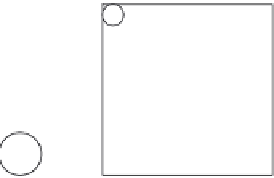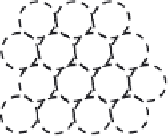Geoscience Reference
In-Depth Information
Fig. 8.1
Illustration of the effect of texture and of
particle size distribution on the porosity. In
boxes (a), (c) and (d) the spherical particles
of uniform size arranged in a cubic packing
(i.e. a similar structure) result in aggregates
with exactly the same porosity, regardless
of the sizes of the particles. The particles in
box (b), which are of different sizes, result
in an aggregate with smaller porosity.
(a)
(b)
(c)
(d)
Fig. 8.2
Illustration of the effect of
structure of spherical
particles of uniform size on
porosity. Among the regular
arrangements, the cubic
packing in (a) is the most
open and the rhombohedral
packing in (b) is the tightest;
(c) shows how secondary
structures (crumbs) can be
formed, resulting in larger
porosities.
(a)
(b)
(c)
charges; these charges affect the structure of the soil, and are increasingly effective with
decreasing particle size. Moreover, their chemical composition can vary widely. Some
of the soil constituents, such as colloidal clay, organic matter, lime, and colloidal oxides
of iron and aluminum, can act as cementing agents, which further the aggregation of
particles into larger structures. As a result, clayey soils tend to have higher porosities
than sandy soils.










































































































































































